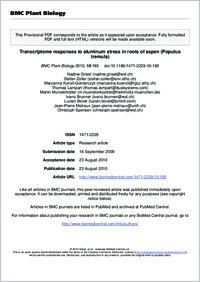Transcriptome responses to aluminum stress in roots of aspen (Populus tremula)
- Grisel, Nadine Swiss Federal Institute for Forest, Snow and Landscape Research (WSL), Birmensdorf, Switzerland
- Zoller, Stefan Functional Genomics Center Zurich, University of Zurich and Swiss Federal Institute of Technology Zurich, Switzerland - Genetic Diversity Centre, Swiss Federal Institute of Technology, Zurich, Switzerland
- Künzli-Gontarczyk, Marzanna Functional Genomics Center Zurich, University of Zurich and Swiss Federal Institute of Technology Zurich, Switzerland
- Lampart, Thomas Swiss Federal Institute for Forest, Snow and Landscape Research (WSL), Birmensdorf, Switzerland - Institute of Chemistry and Biological Chemistry, Zurich University of Applied Sciences, School of Life Sciences and Facility Management, Wädenswil, Switzerland - Dualsystems Biotech AG, Schlieren, Switzerland
- Münsterkötter, Martin Institute of Bioinformatics and System Biology, Helmholtz Center Munich, Ingolstädter, Neuherberg, Germany
- Brunner, Ivano Swiss Federal Institute for Forest, Snow and Landscape Research (WSL), Birmensdorf, Switzerland
- Bovet, Lucien Department of Biology, University of Fribourg, Switzerland - Philip Morris International Research & Development, Philip Morris Products SA, Neuchâtel, Switzerland
- Métraux, Jean-Pierre Department of Biology, University of Fribourg, Switzerland
- Sperisen, Christoph Swiss Federal Institute for Forest, Snow and Landscape Research (WSL), Birmensdorf, Switzerland
-
23.08.2010
Published in:
- BMC Plant Biology. - 2010, vol. 10, p. 185
English
Background: Ionic aluminum (mainly Al3+) is rhizotoxic and can be present in acid soils at concentrations high enough to inhibit root growth. Many forest tree species grow naturally in acid soils and often tolerate high concentrations of Al. Previously, we have shown that aspen (Populus tremula) releases citrate and oxalate from roots in response to Al exposure. To obtain further insights into the root responses of aspen to Al, we investigated root gene expression at Al conditions that inhibit root growth.Results: Treatment of the aspen roots with 500 μM Al induced a strong inhibition of root growth within 6 h of exposure time. The root growth subsequently recovered, reaching growth rates comparable to that of control plants. Changes in gene expression were determined after 6 h, 2 d, and 10 d of Al exposure. Replicated transcriptome analyses using the Affymetrix poplar genome array revealed a total of 175 significantly up-regulated and 69 down-regulated genes, of which 70% could be annotated based on Arabidopsis genome resources. Between 6 h and 2 d, the number of responsive genes strongly decreased from 202 to 26, and then the number of changes remained low. The responses after 6 h were characterized by genes involved in cell wall modification, ion transport, and oxidative stress. Two genes with prolonged induction were closely related to the Arabidopsis Al tolerance genes ALS3 (for Al sensitive 3) and MATE (for multidrug and toxin efflux protein, mediating citrate efflux). Patterns of expression in different plant organs and in response to Al indicated that the two aspen genes are homologs of the Arabidopsis ALS3 and MATE.Conclusion: Exposure of aspen roots to Al results in a rapid inhibition of root growth and a large change in root gene expression. The subsequent root growth recovery and the concomitant reduction in the number of responsive genes presumably reflect the success of the roots in activating Al tolerance mechanisms. The aspen genes ALS3 and MATE may be important components of these mechanisms.
- Faculty
- Faculté des sciences et de médecine
- Department
- Département de Biologie
- Language
-
- English
- Classification
- Biological sciences
- License
-
License undefined
- Identifiers
-
- RERO DOC 20537
- DOI 10.1186/1471-2229-10-185
- Persistent URL
- https://folia.unifr.ch/unifr/documents/301604
Statistics
Document views: 109
File downloads:
- pdf: 178
